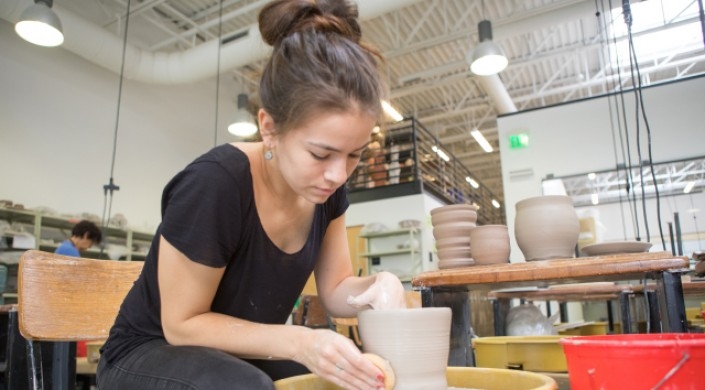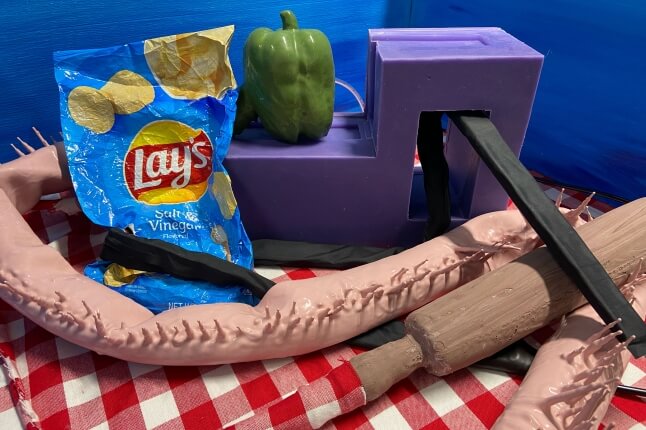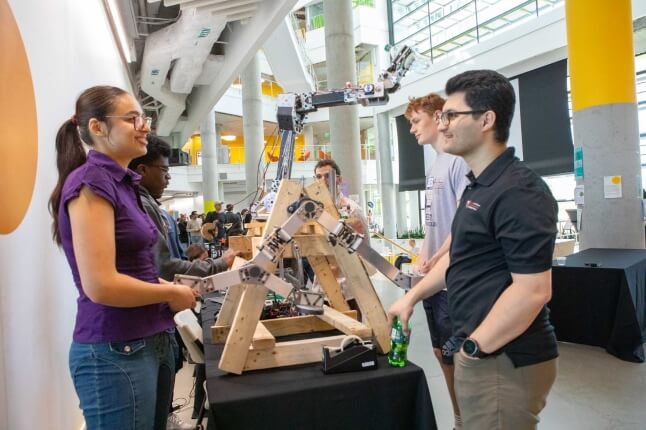News
Mechanical engineering concentrator Rebecca Gracia, S.B. '18, is combining her interest in engineering with her passion for ceramics. (Photo by Eliza Grinnell/SEAS Communications.)
Rebecca Gracia carefully runs her hands along the lump of clay turning in front of her, slowly rounding the edges of the wet, gray slab. Across the room, a specialized 3D printer is autonomously creating a ceramics project of its own, gears whirling as it precisely applies layers of wet clay.
This juxtaposition of human artist and machine exemplifies the commonalities that exist between the worlds of engineering and art, said Gracia, S.B. ’18, a mechanical engineering concentrator at the Harvard John A. Paulson School of Engineering and Applied Sciences (SEAS).
Earlier this year, Gracia joined a group of students from Harvard and MIT to build the ceramics 3D printer during a workshop with Bryan Czibesz, Assistant Professor of Ceramics at SUNY New Paltz. The device, which includes a triangular arrangement of motors to drive the position of a clay tube, uses parameters of trigonometry to ensure clay is extruded evenly.
Most 3D printers common in engineering operate along a Cartesian coordinate system, Gracia explained, so it was unique to work with a machine that uses a delta configuration. But since the device constantly extrudes clay during printing, it can be difficult to correct a mistake, she said.
In ceramic 3D printing, environmental factors play a large role, too. The humidity in the air and the moisture content of the clay can change day-to-day. Clay that is too dry can break off from the piece, but if it is too wet it won’t be strong enough to support itself, she said.
“This is where the artistic part of ceramics comes in,” she said. “A lot of times, there is a subtle art of feeling your way about a piece. When you are throwing ceramics, you are constantly thinking of the clay—is it too hard or too soft, will it dry out, will it give me the effect that I want? That’s the same way you have to think when you are 3D printing.”
Gracia, who has been making ceramics since high school, is now thinking about her artwork from an engineering perspective. (Photo by Eliza Grinnell/SEAS Communications.)
Gracia, who has been making ceramics since high school, enjoyed seeing how the 3D printer enabled a level of precision that is impossible to attain by throwing or hand sculpting.
“I was able to think about ceramics from an engineering perspective,” she said. “The design process in both is quite similar. They come from a very artistic place, but I generally never consider the two together. I started thinking a lot about how I can incorporate my knowledge of engineering into ceramics.”
That experience inspired Gracia to use ceramics as the central theme of her engineering thesis project. She is building a combination kiln for the Harvard Ceramics Program that will enable both wood and propane firing.
Artists prefer different types of firing for certain projects, she explained. While wood firing is much more involved—the artist must be on hand to stoke the flames and manage the wood to ensure the proper temperature is maintained—propane firing is streamlined.
“Wood firing is a point of interest for potters because they enjoy being a part of that process. It is almost a communal thing, like a campfire. You feel like you have a lot of control over what is happening to your work,” she said. “A lot of times with gas-fired kilns, it is this black box where you send in your piece and you hope you are going to get what you want out of it.”
As she designs and builds the device, the biggest challenge has been ensuring the system remains user-friendly for artists who likely lack engineering experience. Gracia is also working to find a cost-effective way to install automated vents, so a potter could easily adjust interior oxygen levels.
Giving potters more control over temperatures could help prevent uneven firings that occur from drafts inside the kiln, or problems that arise due to changes in humidity and weather.
As she works through those design challenges over the course of the academic year, Gracia will draw on her engineering skills and artistic sensibilities.
“As much as we’d love to perfect and automate the process, that is not the case. There are so many variables,” she said. “That’s why I think ceramics is so interesting. Even though there is this technology to give it perfection, there is still a lot of craftsmanship involved.”
For her engineering thesis project, Gracia is developig a combination kiln that will enable both wood and propane firing. (Photo by Eliza Grinnell/SEAS Communications.)
Topics: Design
Cutting-edge science delivered direct to your inbox.
Join the Harvard SEAS mailing list.
Press Contact
Adam Zewe | 617-496-5878 | azewe@seas.harvard.edu



